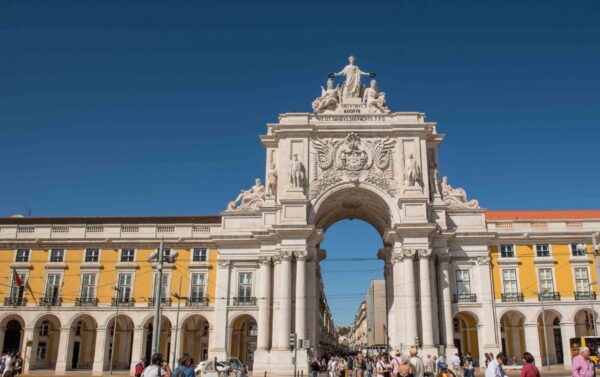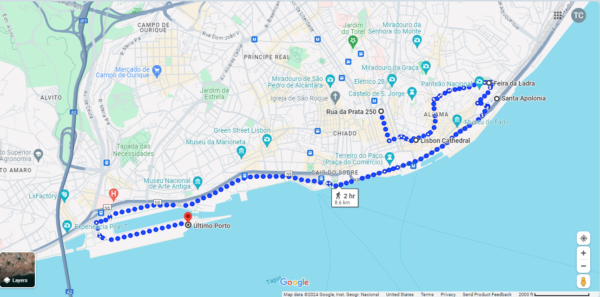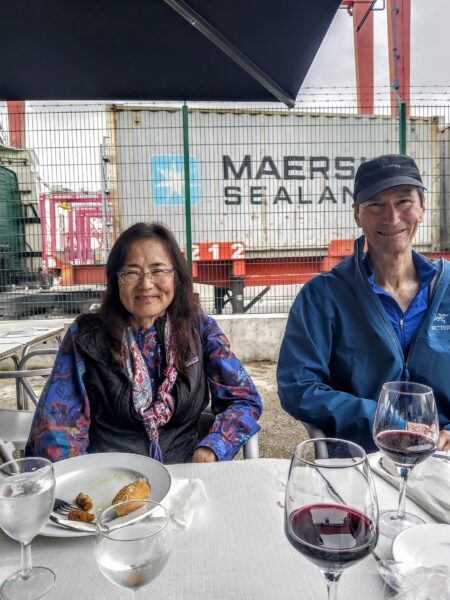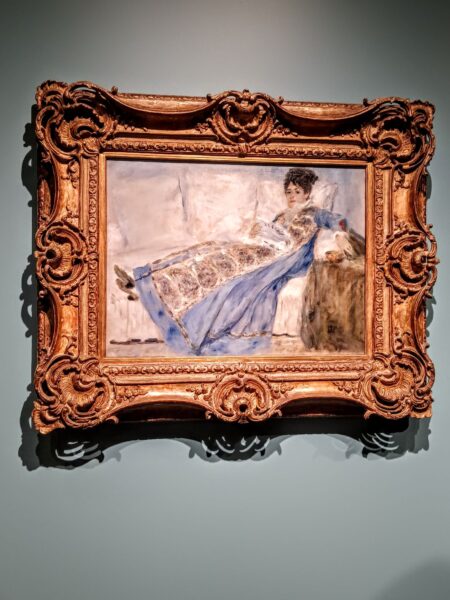As my family was jetting west toward the United States, my friends K & P were eastbound toward Portugal. Although they were both transiting the Atlantic, I’ll go out on a limb and say they never passed close enough to wave at one another. Although I’ve known K & P for more than 40 years, we certainly hadn’t seen each other since before the Covid-19 pandemic so although they’d been out of sight for many years they’re among the very few who have been connected with me for so long a time. I knew their visit would be quite different from that of my family but I’ll use the same approach and only detail those activities that were new to me.
Top of the Arch
Originally used as a bell tower, construction of the Arco da Rua Augusta began soon after the earthquake of 1755 but didn’t achieve its current form until 1875. It’s a triumphant symbol but not of a military victory. Rather, it celebrates Portugal’s recovery from that temblor. (Remember, it’s only half jokingly said that the Portuguese temporally divide the world into the period before the earthquake and after it.)

Calling the structure monumental feels like a bit of understatement. Although not quite as large as the Arc de Triomphe de l’Etoile in Paris, the arch portion is nine meters wide and rises to a height of 22 meters. The entire structure crests at 39 meters making it larger than both Berlin’s Brandenburg Gate and London’s Wellington Arch.
Long before I left for this extended stay, I’d asked P & K to give me a sense of some of the things they might enjoy doing or seeing in and around Lisboa. They sent me a list that included going to the top of the Arch. Since they arrived in the morning and could only leave their bags at their hotel, and since the Arch was a short walk, this seemed the ideal day to check that off the list.
We strolled down rua Augusta, paid the small entry fee, and took the elevator to the stone floored interior room where we saw the 1941 clock. We then climbed the narrow spiral staircase to reach the exterior and take in its panoramic views of Lisboa including this one with a dark cloud hanging over the Castelo.

K & P came prepared and eager to explore Lisboa on foot – my favorite means of doing so. Thus, from the arch, we walked to Cais do Sodré and stopped in the Merecado da Ribeira which was, unfortunately, in the process of shutting down for the day. However, the Time Out Market was open and this was where we had our lunch.
Thursday, we visited some of the Castelo and several nearby Miradouros including Santa Luzia, Graça, and Senhora do Monte. Since I had been to all these places, I didn’t take many photos but you can see the few I did take in this album.
Our Time
I’ve covered much of what I did with K & P in other posts about Lisboa but one new thing for me requires a much lengthier explanation than I can summarize in a few hundred words so I’m going to make a temporal jump over Friday’s Culinary Backstreets Food Tour and cover what we did on Saturday and Monday.
Saturday’s report is fairly easy. We started the day by walking up the hill to the Feira da Ladra then wandering down through Alfama to Santa Apolónia. From there, K & P wanted to walk to Último Porto a restaurant our food tour guide had recommended. So we set off on an eastward trek along the river.
Reaching the restaurant proved to be something of an adventure. Our guide, Ines, had told us of a bridge that we could cross to reach this very working class restaurant that sits by the port. However, when we eventually found it, we learned that it only operates under certain circumstances that didn’t include an ordinary Saturday. Thus, were were essentially compelled to follow the route plotted on the Google Maps screen capture seen here:

which necessitated walking about a kilometer past the location and looping back. The map shows a total distance of just over eight kilometers but I suspect it was a bit more given the circuit we made around Lisbon’s famous flea market. It was a very good lunch in a very interesting atmosphere

and certainly far enough away from the usual tourist areas that it’s a wonderful place to get a double dose of local flavor. However, I think I might have enjoyed it more had we set out directly from our neighborhood and walked only five kilometers and had I not been in a pair of new shoes one of which was rubbing a blister just below my lateral malleolus.
This meal we had on Saturday. Sunday, we went to Belém and had another long walk along the river that included a stroll across the top of the MAAT – Museum of Art Architecture and Technology. I took a few photos and you can see those here.
Museu Calouste Gulbenkian at last
Most of you probably don’t recall that on my last day here in 2023, I set off to see the collection at the Calouste Gulbenkian Museum. The walk was more strenuous that I anticipated. Although it was only about 3.5 kilometers, it seemed as though the entire distance was uphill and by the time I reached the garden outside the museum I felt too tired and sore to do anything but rest and stroll around the garden.
As I’ve noted elsewhere, most of the municipal museums are closed on Mondays. As a private museum, Museu Calouste Gulbenkian is not. Thus it was that my friends and I set out for that museum Monday morning. I think the walk seemed less strenuous because we started early in the day and because I knew what the walk entailed.
For the most part, I found the visit well worth the wait. We started in a special exhibition called Treasures from Kings. Items on display were on loan from Jerusalem’s Terra Sancta Museum and were mainly pieces that had been donated to that museum by European Catholic Monarchs. While almost every item shown had an element of grandeur whether in workmanship or materials, I reacted more strongly to to the degree to which the resources used in their creation could have been better utilized serving tangible needs of the people these monarchs ruled and churches purportedly served than to any supposed sanctity they might have been intended to display.
I found the permanent collection much more inspiring in both the range of its antiquity and its geography. I don’t know how many of the 6,000 artifacts and works of art from Gulbenkian’s personal collection were on display but we began with 4,000 year old artifacts from ancient Egypt through Greece, Rome and Mesopotamia to the Islamic East

then continued our eastward journey into works from China and Japan before circling back to art from Europe spanning the twelfth to the nineteenth centuries such as this Renoir portrait.

As I walked through this wide ranging collection, I was struck once again by the realization that artistic expression seems to be essential to our humanity. For all our current focus on technology and the so-called STEM curricula in education, human beings began creating art long before they developed systems of writing or scientific methodologies. Expressive creativity is in our nature and we should never limit or neglect it.
I only took a few photos at the museum but you can see them here. In the coming posts, I’ll be stepping back in time in more ways than one.